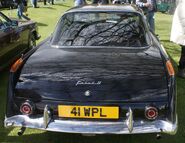
Facel Vega Facel II
The Facel Vega 'Facel II' was a French Grand Touring car produced by Facel between the years 1962 and 1964.
By 1962 the Paris-based Facel Vega company was facing bankruptcy. The Facel II (pronounced '2') was to be the company's last attempt to create a luxury GT car in the French tradition.
The Facel II was very expensive and highly exclusive. Its handsome design led to famous owners, including Pablo Picasso, Lionel Bart, John Bloom, Lord Brabourne, The Chrysler Corporation (and Mrs Carr, Walter Chrysler's daughter), Joan Collins, Tony Curtis, Christian Dior, Stanley Donen, Charlie Drake, Max Factor Jr, Joan Fontaine, Ava Gardner (who bought three), The Marchioness of Huntly (whose car had full-harness seat-belts), Herbert von Karajan, Danny Kaye, Louis Malle, The President of Mexico, Princess Grace of Monaco, Yves Montand, Hassan II King of Morocco, Baroness Sally Oppenheim-Barnes, William S. Paley, Prince Poniatowski, Anthony Quinn, Debbie Reynolds, Frank Sinatra, Ringo Starr, The Marchioness of Tavistock, François Truffaut, Robert Wagner, Sir Mortimer Wheeler, The Shah of Persia and Sihanouk King-Father of Cambodia. Race drivers Sir Stirling Moss, Maurice Trintignant, Tony Vandervell and Rob Walker had Facels.
The Facel Vega company advertised the Facel II as "Le Coupe 4-places le plus rapide du Monde" ('The Fastest 4-seater Coupe in the World'). 'Sports Car Graphic' described it as a "luxurious brute".
It was powered by an American 6.3 litre (383 cu.in.) Chrysler 'Typhoon' engine which produced 355 hp (265 kW) in automatic-gearbox form and 390 hp (291 kW) in manual. Using Chrysler's three-speed Torqueflite automatic gearbox, the 6.3 litre Facel II could reach over 135 mph (225 km/h). With a French Pont-a-Mousson 4-speed manual gearbox the full-four-seater 6.3 litre Facel II could attain over 150 mph (247 km/h) and out-accelerate its two-seater rivals, the Aston Martin DB4, Ferrari 250 GT and 'gull-wing' Mercedes-Benz 300SL to 60 mph (97 km/h) and all except the Ferrari to 100 mph (160 km/h). Dunlop disc brakes were fitted on all four wheels and Hydrosteer power steering, leather seats, electric windows and radio aerial all became standard during the production run, with Armstrong Selecta-Ride shock-absorbers adjustable from the dash while driving fitted to the right-hand-drive British models. The curvaceous wrap-round dash was in fact metal but meticulously painted to look like wood. Many of the controls where airplane inspired. The later 'manuals' were fitted with the even more powerful 6.7 litre (413 cu.in.) Chrysler "RB" wedge engine and were faster still.
Like its predecessor, the Facel Vega HK500, the Facel II was heavier than its two-seater rivals, weighing 1,880 kilograms (4,100 lb) (37 cwt) 'dry' and almost two tons with four passengers and a full petrol tank. There may have been some question about its ride and rear suspension - it used suspension virtually unchanged from the previous HK500 - but certainly none about its speed or glamour.
England's 'Autocar' said of it, "To step down into a Facel II and go motoring must be the ambition of many who can never fulfil it. Such an experience is reserved for the few who can afford to buy one and for their friends and acquaintances". For 'Motor', "There are faster sports cars, although very few, and there are more refined and luxurious saloons, but it is difficult to think of a more remarkable combination of these rather conflicting qualities ..... its unique combination of qualities left the most vivid impression on everyone who drove it. In particular one remembers the smoothness and silence, the effortless gate of a car which does 100 mph (160 km/h) at only 3,650 rpm. and the acceleration which leaves other fast cars far behind on every straight. One can enjoy the latest refinements of American brute force with European standards of control in an environment of British luxury and French elegance".
In August 1961 Jean Daninos, Facel's president was obliged to offer his resignation and in 1964 the Facel company went into receivership, largely due to warranty claims against Facel Vega's smaller Facellia with its troublesome 'in-house' engine.
Facel II production was discontinued with only 180 Facel IIs ever built. Jean Daninos, its creator and manufacturer, said of the Facel II, "The HK 500 was the most interesting car we ever made but the Facel II was by far the best. It was totally "elegant".
The remaining Facel IIs are now amongst the most sought-after of all 1960s Grand Tourers.

